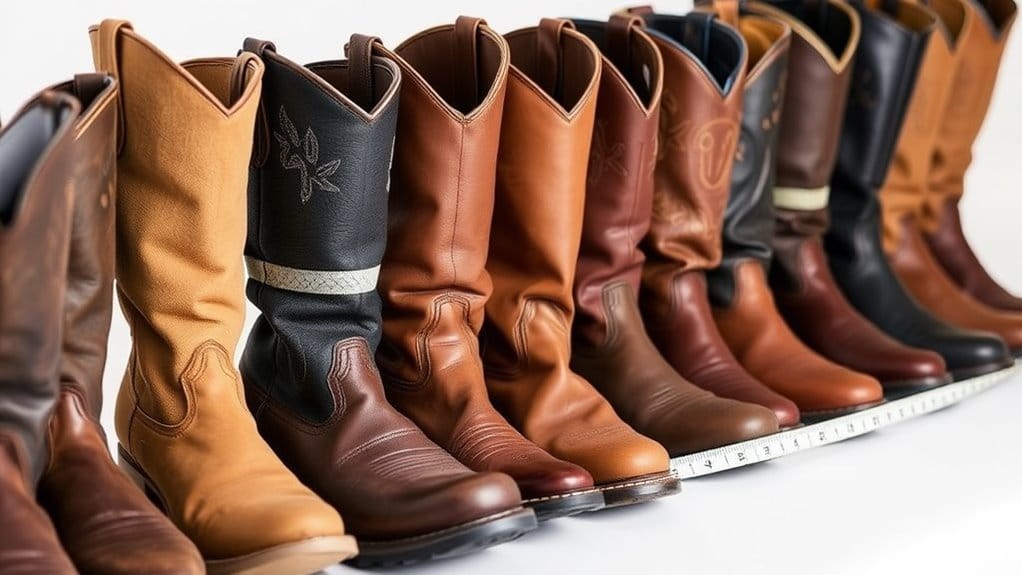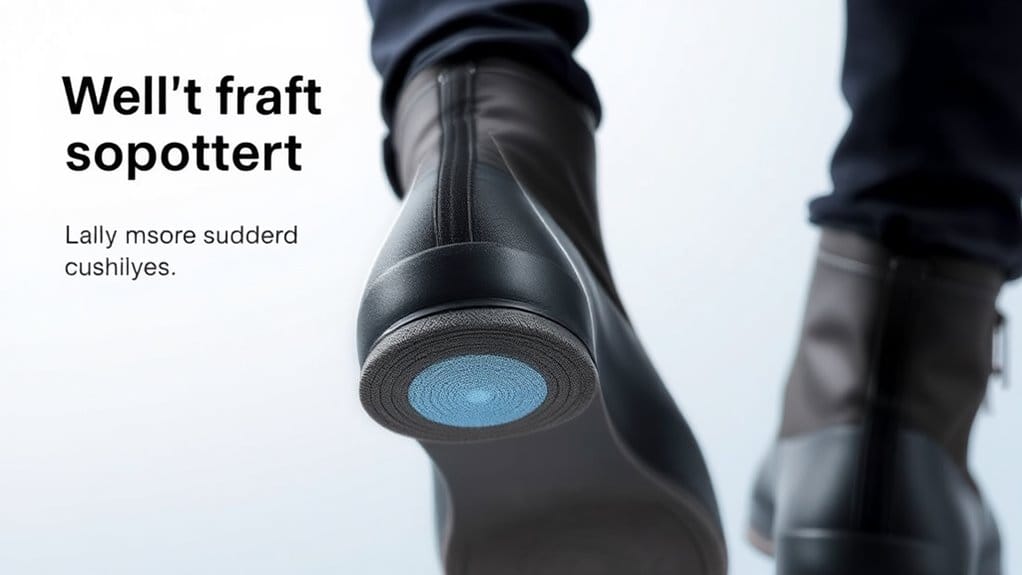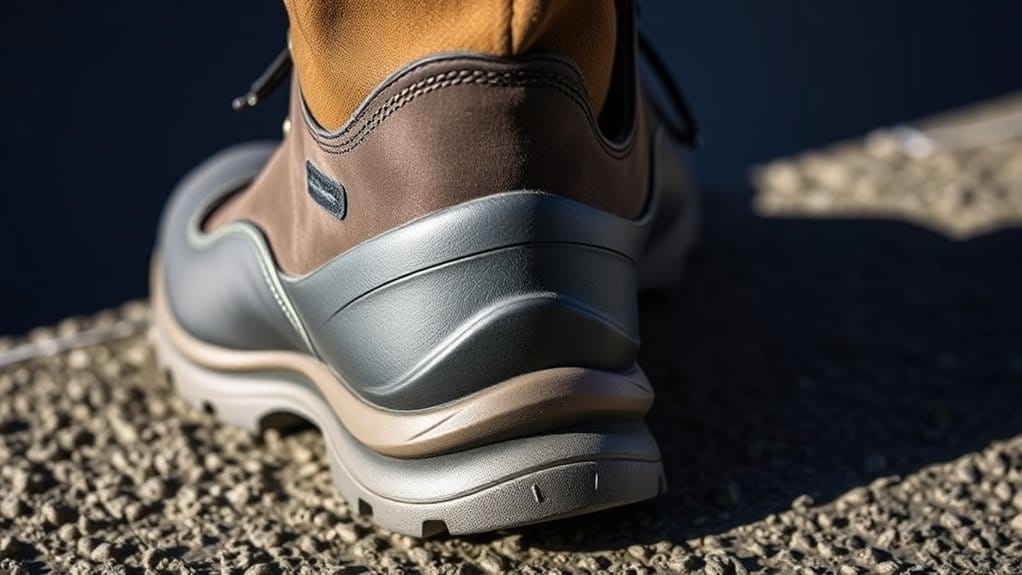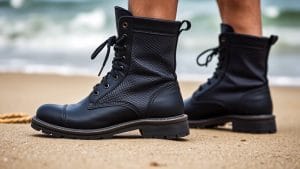This post contains affiliate links. As an Amazon Associate, we earn from qualifying purchases.
Your boots should fit snugly but comfortably, allowing for some wiggle room in your toes. Aim for about a half-inch of space beyond your longest toe and make sure your heel is secure without slipping. Proper arch support is essential based on your foot type. Always try on boots with the socks you'll wear to ensure an accurate fit. If you want to discover more tips and techniques for getting the perfect fit, keep exploring!
Key Takeaways
- Ensure a snug heel fit to prevent movement and provide ankle stability while allowing your toes to wiggle freely.
- Maintain about a half-inch of space beyond your longest toe for proper toe room and comfort.
- Select the right width to avoid pinching; consider narrow, medium, wide, or extra-wide options based on your foot shape.
- Assess arch support needs based on your arch type—low, neutral, or high—to enhance overall comfort during wear.
- Always try on boots with intended socks and walk around to identify any pressure points or discomfort.
Understanding Boot Sizes and Widths

When you're shopping for boots, understanding sizes and widths is crucial to finding a comfortable fit.
Boot sizing typically follows a numerical system, but it's essential to consider width measurements as well. Widths are usually categorized as narrow, medium, wide, or extra-wide.
To determine your size, measure your foot length and refer to the manufacturer's size chart. Remember, different brands may have slight variations in sizing, so it's wise to try on several pairs.
When assessing fit, ensure your toes have enough room without feeling cramped, and check that the boots don't pinch your sides.
Proper boot sizing and width measurements can make all the difference in comfort, especially if you plan to wear them for extended periods.
The Importance of Arch Support

When it comes to boot fit, arch support plays a crucial role in your overall comfort.
Different types of arch support cater to various foot shapes and can significantly enhance your walking experience.
Understanding these options can help you choose the right boots and prevent discomfort during long wear.
Types of Arch Support
Understanding the types of arch support is crucial for ensuring your boots fit properly and provide the comfort you need.
There are three main arch types: low (flat), neutral, and high. Each type requires different support to maintain balance and reduce strain.
For low arches, you'll benefit from firm support that prevents excessive pronation. Neutral arches typically need moderate support, while high arches often require cushioning to absorb shock.
Custom orthotics can be a game-changer, as they're tailored specifically to your feet, offering optimal support for your unique arch type.
Assessing your arch type and choosing the right support ensures your boots not only fit well but also enhance your overall walking experience.
Benefits for Comfort
Proper arch support isn't just a luxury; it's essential for your comfort and well-being while wearing boots. When you have the right support, you'll experience improved boot cushioning that alleviates pressure on your feet. This can prevent fatigue, allowing you to stay on your feet longer without discomfort.
Additionally, effective arch support contributes to better moisture management, keeping your feet dry and reducing the risk of blisters or fungal infections. It helps maintain proper foot alignment, which can also minimize the risk of injuries.
Ultimately, investing in boots with adequate arch support means you're prioritizing your comfort and foot health, ensuring a more enjoyable experience whether you're walking, hiking, or working.
Assessing Heel Fit and Stability

When assessing heel fit and stability, start by considering the heel height of your boots.
A proper heel height should enhance your balance without compromising comfort during movement.
Ensure that your heel feels secure and doesn't slip, as this stability is crucial for effective support.
Heel Height Considerations
How do you determine the right heel height for your boots? Start by considering your comfort levels and the activities you'll engage in.
A lower heel height typically offers more stability and comfort for everyday wear, while a higher heel can elevate your style but may compromise comfort over time.
It's essential to understand that different heel heights affect your posture and weight distribution.
Try on boots with various heel heights to assess how each feels during movement. Pay attention to any pressure points or discomfort, as these can signal an improper fit.
Ultimately, choose a heel height that balances your aesthetic preferences with your need for comfort, ensuring you feel confident on your feet all day long.
Stability During Movement
To ensure your boots provide the right stability during movement, it's crucial to assess both the heel fit and overall construction. A snug heel fit prevents unnecessary movement, which can compromise ankle support and lead to discomfort or injury.
When trying on boots, pay attention to how your heel sits; it should feel secure without being overly tight. Proper foot alignment is vital for effective movement, so check that your toes have enough space to wiggle without pushing against the front.
Look for boots designed with supportive features like contoured insoles or reinforced heel counters. This combination not only stabilizes your foot but also enhances overall performance, allowing you to move confidently in various terrains.
Evaluating Toe Space and Comfort
Are you feeling cramped or comfortable in your boots? Evaluating toe space is crucial for a proper fit. Your toes should have enough room to wiggle without hitting the front of the boot.
Ideally, there should be about a half-inch of space beyond your longest toe, which varies depending on your toe length.
Consider your foot shape as well; wide feet might need a boot with a broader toe box. If your toes feel pinched or you're experiencing discomfort, it's time to reassess your choice.
Uncomfortable boots can lead to blisters and long-term foot issues. Always try on boots with the socks you plan to wear to ensure a snug yet comfortable fit that accommodates your unique foot shape.
The Role of Boot Materials in Fit
While you might focus on the size and shape of your boots, the materials used in their construction play a crucial role in how they fit. Different materials offer varying levels of material flexibility, which impacts your comfort and mobility.
For example, leather provides durability and molds to your foot over time, while synthetic materials may offer more immediate flexibility. Additionally, consider the insulation properties of the materials. Insulated boots can keep your feet warm in cold conditions, but if they're too thick or stiff, they can restrict movement.
Ultimately, the right combination of material flexibility and insulation can enhance your overall fit and performance, ensuring your boots support you effectively in various environments.
Trying Boots On: Best Practices
When you try on boots, it's essential to pay attention to several key factors to ensure a proper fit.
Start by selecting the right boot types for your needs, whether they're hiking, work, or fashion boots.
Use proper fitting techniques: wear the socks you plan to use with the boots, and stand up while trying them on.
Ensure there's enough space in the toe box; you should be able to wiggle your toes.
Check for heel slippage—your heel shouldn't lift excessively.
Walk around and pay attention to any pressure points; they could indicate an improper fit.
Lastly, remember to consider width, as many boot types offer various width options for a customized feel.
Breaking in Your Boots
Once you've found the right pair of boots, the next step is breaking them in to ensure maximum comfort and performance.
Start by wearing your boots for short periods around the house. This helps identify any pressure points that may need adjustment.
Use breaking techniques like flexing the boots by bending them while seated or walking on various surfaces to soften the material.
If necessary, consider boot adjustments such as using thicker socks or inserting padded insoles for added comfort.
Gradually increase your wear time, allowing the boots to mold to your feet.
Remember, patience is key; don't rush the process.
A well-broken-in pair of boots will enhance your experience, whether you're hiking or simply enjoying daily activities.
When to Seek Professional Fitting Assistance
How can you tell if it's time to get professional fitting assistance for your boots? If you consistently experience discomfort, blisters, or pinching, seeking professional advice is a smart move.
A proper fit is crucial for both comfort and support, especially if you're planning long hikes or daily wear. Professional fitters utilize various fitting techniques to assess your foot shape, arch, and width, ensuring your boots match your unique requirements.
If you've tried adjusting laces, insoles, or sizes without success, don't hesitate to consult an expert. They can provide tailored recommendations to enhance your boot experience.
Frequently Asked Questions
How Do I Know if My Boots Are Too Tight?
If you experience boot discomfort or notice foot swelling after wearing your boots, they're likely too tight. Your toes shouldn't feel cramped, and you should have enough space to wiggle your feet comfortably.
Can I Stretch My Boots at Home?
Yes, you can stretch your boots at home. Use methods like wearing thick socks, applying heat with a hairdryer, or using boot stretchers. These techniques help loosen tight areas, making your boots more comfortable to wear.
How Often Should I Replace My Boots?
You should replace your boots every 6 to 12 months, depending on the boot material and your boot care routine. Regular maintenance can extend their life, but worn-out soles or cracks signal it's time for new ones.
What Type of Socks Should I Wear With Boots?
When choosing socks for boots, opt for moisture-wicking materials like merino wool or synthetic blends. Also, consider sock thickness; thicker socks provide warmth, while thinner socks enhance breathability and comfort during extended wear.
Are There Specific Brands Known for Better Fit?
When considering brand comparisons, look for companies that prioritize fit technologies. Brands like Merrell and Salomon often offer specific features enhancing comfort and support, ensuring you find boots that suit your foot shape and activity.
Conclusion
Finding the right fit for your boots is essential for comfort and support. Remember to consider size, width, arch support, and toe space when trying them on. Pay attention to heel stability and the materials used, as they can affect overall fit. Breaking in your boots properly will enhance their comfort. If you're unsure about the fit, don't hesitate to seek professional assistance. Your feet deserve the best, so invest the time to find the perfect pair.



